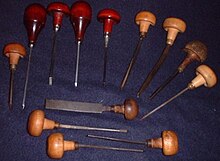Olga Herlin
She introduced new working methods and served for nearly 50 years at the Swedish Kingdom's general mapping service and its predecessors.
Herlin was able to streamline this process in 1901 in such a way that the map was directly pantographed onto the gelatin paper, from which the image was printed on the copper plate.
[2] In 1903, Herlin was paid as an extra engraver at the Kingdom's general cartography with a daily working time of 5 hours, but she did not get annual leave until 1908.
For example, the Danish Sea Chart Office was using a new method for laying the copper plate, which she then introduced in Sweden.
From 1 July 1923, she was employed as an extra executive with 6 hours of daily working time, but not until 1927 could she apply for and obtain a regular position as an engraver.
[2] In February 1927, Herlin asked the King Gustaf V to credit her service with her previous unofficial employment at the office so she could qualify for a pension.
[2] In the first parliamentary chamber in 1928, Member of Parliament Kerstin Hesselgren motioned for Herlin to be credited with half of her service time in order to be promoted in salary class, which was necessary to qualify for a pension.
By the Mapping Authority's regulatory letter in June 1929, Olga Herlin was finally promoted to a higher salary class.
